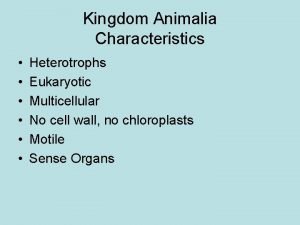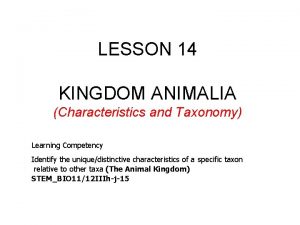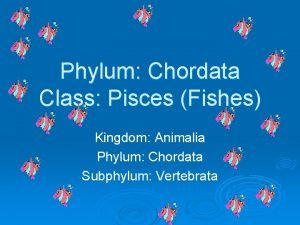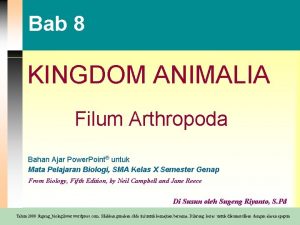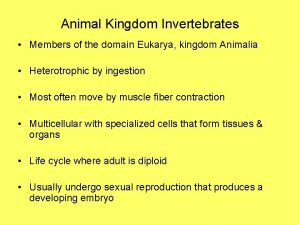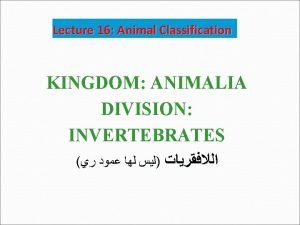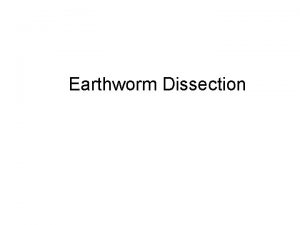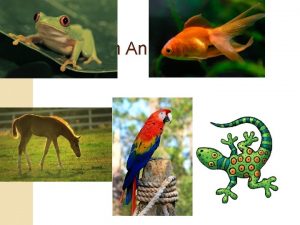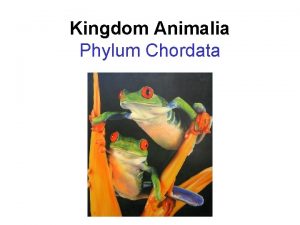Grasshopper Dissection Classification of Grasshopper Kingdom Animalia Multicellular



















- Slides: 19

Grasshopper Dissection

Classification of Grasshopper Kingdom Animalia: Multicellular eukaryote, heterotrophic, can move about Phylum Arthropoda: Exoskeleton, jointed appendages, segmented body Class Insecta: Three pairs of legs, three main body segments, unbranched appendages, one pair of antennae

Objectives: 1. Understand all major grasshopper systems for maintaining homeostasis. 2. Correctly dissect a grasshopper and accurately identify various grasshopper organs and systems. 3. Understand how the grasshopper fits into the world. 4. Master (85%) both the dissection quiz (in class) and the online guide quiz (UTIPS).

All living things must maintain a relatively stable internal environment to survive. The term used to describe this is "homeostasis. " Living things carry out different essential functions in order to accomplish this task. Multicellular organisms have “systems” that work together to maintain this stable environment. For example when you run your body is placed under sever stress. Various systems will start to work overtime keeping your body alive. Your heart starts beating faster and your breathing increases. Your body is trying to deliver oxygen and take away carbon dioxide (respiratory waste) form working muscles etc. Your skin starts to sweat reducing the excess body heat created by the activity. Without your body systems working together your systems will fail and death would ensue. There are many more system accommodations that occur as you run or engage your body in different activities. Multicellular organisms maintain homeostasis differently. Compare the differences between warmblooded and cold blooded organisms. To adjust body temperature insects or reptiles will move their body to a location that will ether warm or cool their body depending on their needs. Below are a few examples of various systems found in multicellular organisms. Digestive /Feeding Response /Nervous Movement Circulatory Respiratory Reproductive Excretion Single celled organisms do not have systems because they are only made of one cell. Thus each cell must carry out all of these functions without relying on tissues, organs and organ systems (ex. bacteria, yeast, and most protists).

Get yourself oriented!! Thorax Abdomen Antenna Head Dorsal Compound eye Posterior Anterior Ventral Metathorax Mesothorax Prothorax

You will be responsible to know most of these parts! Pronotum

Feeding (digestive), Grasshoppers have very intricate mouth. It consists of mandibles, maxillas and palps to guide the food where it needs to go. Grasshoppers eat plant matter. Labrum Hypopharynx Maxilla Labium Mandibles

Intestine Rectum Anus Stomach Gastric Caecum Crop

Respiration, (respiratory system) Grasshoppers have small holes all along their abdomen called spiracles that oxygen in and carbon dioxide out. The actual gas exchange occurs in the tracheal tubes just inside the spiracles.

Circulation, (circulatory) Grasshoppers, like all Arthropods, have an open circulatory system. They have some small blood vessels and a small heart, that pumps blood around at very low pressures.

Excretion (excretory system) Grasshoppers have Malpighian tubules which filter out the wastes from the blood and lead it into the intestine to be excreted. These Malpighian tubules are all of the stringy tissue you will see all around the intestine. Malpighian tubules

Response (nervous) Grasshoppers have a small brain and some nervous tissue. We see here the dorsal nerve cord running along the dorsal side of the grasshopper. The brain is located on the anterior end inside the head. They also have sensory organs such as the auditory sac, which senses vibrations and allows the grasshopper to hear. They have compound eyes which allow them to see. Auditory Sac Dorsal nerve cord

Movement (skeletal and muscular) Grasshoppers have six legs which allow them to jump high and far to move around. These legs are called the prothoracic, mesothoracic and metathoracic legs and they have one of each on either side of their bodies. They also have wings which allow them to jump higher and farther than their legs alone. Anterior wing Posterior wing Metathoracic leg Mesothoracic leg Prothoracic leg

Parts of the leg Tarsus Tibia Femur

Reproduction, (reproductive system) There are male and female grasshoppers, and they reproduce sexually through internal fertilization. After the eggs are fertilized in the female, they will be deposited by the ovipositor into the perfect spot!!

Unlike some other insects, grasshoppers do not go through a complete metamorphosis during their development. The diagram on the left shows how the immature grasshopper looks very similar to the adult.

Before You Start The Dissection 1. Go through this Power. Point before you come to class and participate in the dissection. 2. Listen and follow ALL rules /safety procedures taught in class. 3. You will complete this dissection with your desk partner. 4. Each student must get safety glasses from the UV box before starting the dissection. The safety glasses must be worn throughout the entire dissection. 5. Listen carefully and pay attention to classroom dissection demonstration. 6. Student not listening or participating in a positive way will be asked to leave the lab and complete book work to receive points for the dissection.

7. When finished with the dissection you will raise your hand request a lab quiz. A lab aid or one of you teachers will come and give you and your partner an oral quiz. This is a team quiz, you both get the same score. We will point out various anatomical structures for you to identify. You will be asked 12 different questions. 8. When finished with your quiz clean your area as instructed and start taking your grasshopper dissection guide notes. Good luck, Mr. G

Works Cited Mr. Glassford’s Image Gallery Biology Text: Miller and Levine
 Old kingdom middle kingdom new kingdom
Old kingdom middle kingdom new kingdom Old kingdom middle kingdom new kingdom
Old kingdom middle kingdom new kingdom Old kingdom middle kingdom new kingdom
Old kingdom middle kingdom new kingdom Capital of egypt during the old kingdom
Capital of egypt during the old kingdom Subphylum of grasshopper
Subphylum of grasshopper Animalia multicellular
Animalia multicellular Nine phyla of kingdom animalia
Nine phyla of kingdom animalia Kingdom animalia cell structure
Kingdom animalia cell structure Characteristics of animalia kingdom
Characteristics of animalia kingdom Plantae cladogram
Plantae cladogram General characteristics of cell
General characteristics of cell Pisces phylum
Pisces phylum Monera protista fungi plantae animalia
Monera protista fungi plantae animalia What are chordates
What are chordates Is a frilled lizard unicellular or multicellular
Is a frilled lizard unicellular or multicellular Kingdom animalia
Kingdom animalia Domain eukarya kingdom animalia
Domain eukarya kingdom animalia Protista prokaryotic
Protista prokaryotic Division of kingdom animalia
Division of kingdom animalia Phylum chordata mammalia
Phylum chordata mammalia





